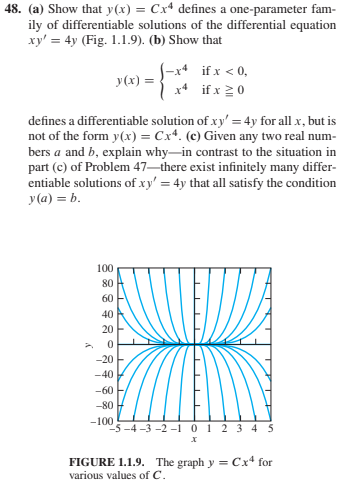48. (a) Show that y(x) = Cx* defines a one-parameter fam- ily of differentiable solutions of the differential equation xy' = 4y (Fig. 1.1.9). (b) Show that (-x* if x < 0, У(х) 3D I x* if x 20 defines a differentiable solution of xy' = 4y for all x, but is not of the form y(x) = Cxª. (c) Given any two real num- bers a and b, explain why-in contrast to the situation in part (c) of Problem 47–there exist infinitely many differ- entiable solutions of xy' = 4y that all satisfy the condition y(a) = b. 100 80 60 40 20 -20 -40 -60 -80 -100 -5 -4 -3 -2 -1 01 2 3 4 5 FIGURE 1.1.9. The graph y = Cx* for various values of C.
48. (a) Show that y(x) = Cx* defines a one-parameter fam- ily of differentiable solutions of the differential equation xy' = 4y (Fig. 1.1.9). (b) Show that (-x* if x < 0, У(х) 3D I x* if x 20 defines a differentiable solution of xy' = 4y for all x, but is not of the form y(x) = Cxª. (c) Given any two real num- bers a and b, explain why-in contrast to the situation in part (c) of Problem 47–there exist infinitely many differ- entiable solutions of xy' = 4y that all satisfy the condition y(a) = b. 100 80 60 40 20 -20 -40 -60 -80 -100 -5 -4 -3 -2 -1 01 2 3 4 5 FIGURE 1.1.9. The graph y = Cx* for various values of C.
Calculus: Early Transcendentals
8th Edition
ISBN:9781285741550
Author:James Stewart
Publisher:James Stewart
Chapter1: Functions And Models
Section: Chapter Questions
Problem 1RCC: (a) What is a function? What are its domain and range? (b) What is the graph of a function? (c) How...
Related questions
Question

Transcribed Image Text:48. (a) Show that y(x) = Cx* defines a one-parameter fam-
ily of differentiable solutions of the differential equation
xy' = 4y (Fig. 1.1.9). (b) Show that
(-x* if x < 0,
У(х) 3D
I x* if x 20
defines a differentiable solution of xy' = 4y for all x, but is
not of the form y(x) = Cxª. (c) Given any two real num-
bers a and b, explain why-in contrast to the situation in
part (c) of Problem 47–there exist infinitely many differ-
entiable solutions of xy' = 4y that all satisfy the condition
y(a) = b.
100
80
60
40
20
-20
-40
-60
-80
-100
-5 -4 -3 -2 -1 01 2 3 4 5
FIGURE 1.1.9. The graph y = Cx* for
various values of C.
Expert Solution
This question has been solved!
Explore an expertly crafted, step-by-step solution for a thorough understanding of key concepts.
This is a popular solution!
Trending now
This is a popular solution!
Step by step
Solved in 5 steps with 5 images

Recommended textbooks for you

Calculus: Early Transcendentals
Calculus
ISBN:
9781285741550
Author:
James Stewart
Publisher:
Cengage Learning

Thomas' Calculus (14th Edition)
Calculus
ISBN:
9780134438986
Author:
Joel R. Hass, Christopher E. Heil, Maurice D. Weir
Publisher:
PEARSON

Calculus: Early Transcendentals (3rd Edition)
Calculus
ISBN:
9780134763644
Author:
William L. Briggs, Lyle Cochran, Bernard Gillett, Eric Schulz
Publisher:
PEARSON

Calculus: Early Transcendentals
Calculus
ISBN:
9781285741550
Author:
James Stewart
Publisher:
Cengage Learning

Thomas' Calculus (14th Edition)
Calculus
ISBN:
9780134438986
Author:
Joel R. Hass, Christopher E. Heil, Maurice D. Weir
Publisher:
PEARSON

Calculus: Early Transcendentals (3rd Edition)
Calculus
ISBN:
9780134763644
Author:
William L. Briggs, Lyle Cochran, Bernard Gillett, Eric Schulz
Publisher:
PEARSON

Calculus: Early Transcendentals
Calculus
ISBN:
9781319050740
Author:
Jon Rogawski, Colin Adams, Robert Franzosa
Publisher:
W. H. Freeman


Calculus: Early Transcendental Functions
Calculus
ISBN:
9781337552516
Author:
Ron Larson, Bruce H. Edwards
Publisher:
Cengage Learning